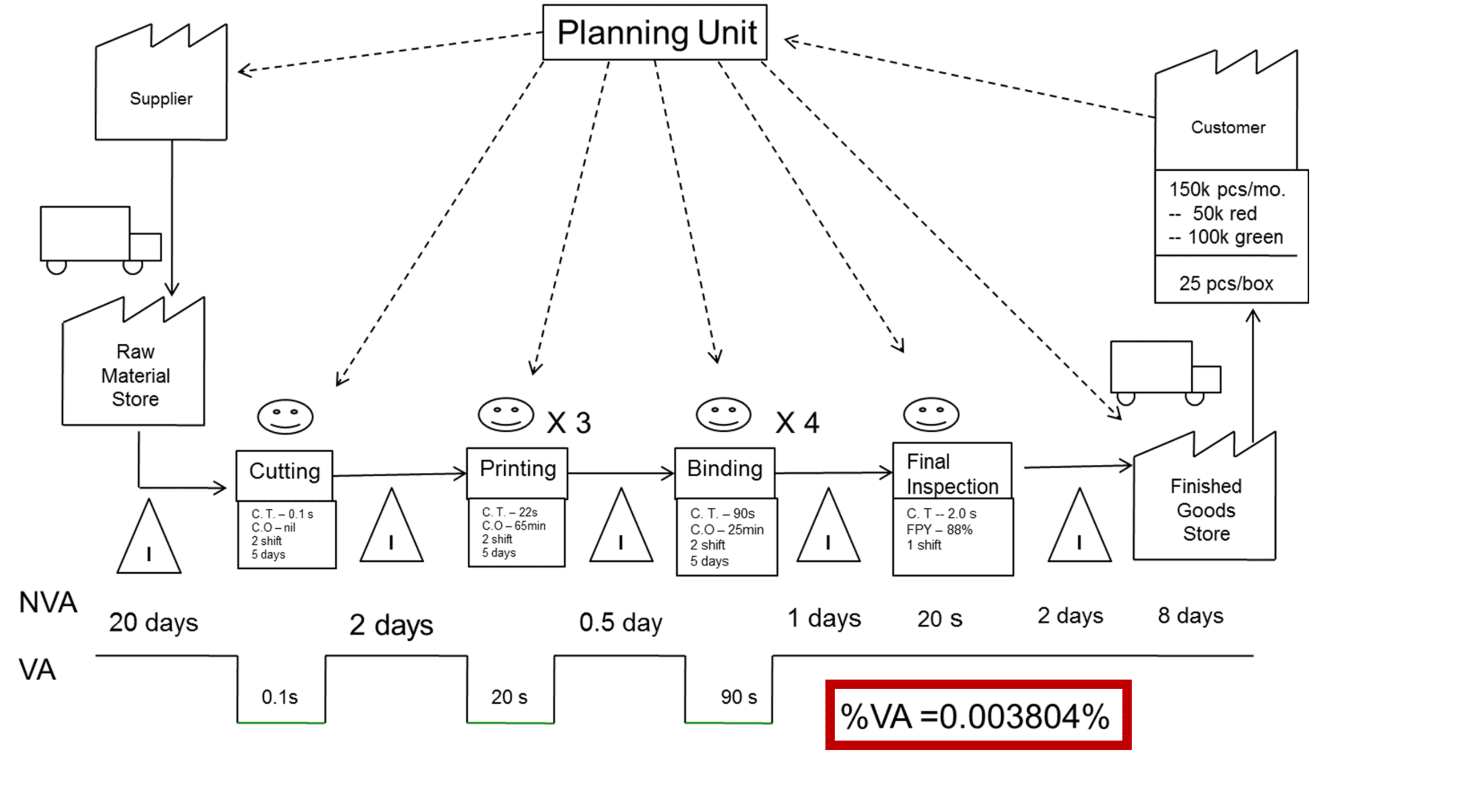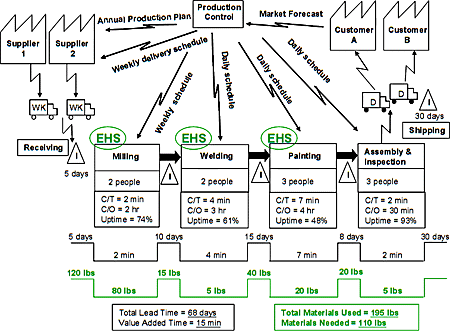- Free Value Stream Mapping Software For Beginners
- Value Stream Mapping Software Free For Mac
- Free Download Value Stream Mapping Software
Value stream mapping templates will give you a productivity boost if you're struggling to create them electronically. I've added this page to my list of helpful lean tools. If you're new to Value Stream Mapping, check out this overview on how to read a value stream map or this post on what is a value stream.
Free Value Stream Mapping Software For Beginners

Quality Glossary Definition: Value stream mapping
Also called: value stream analysis, lean process mapping
- The Value Stream Map helps identify opportunities for removing waste from a process. In some complex processes some steps will be identified as non-value add, but necessary. For example, if a management team decides to fund a ERP upgrade project, it would be best to have a general overview of the company’s needs before calling in consultants.
- Value Stream Maps and More SmartDraw is much more than just value stream mapping software. SmartDraw includes specialized templates for 70 different types of visuals—mind maps, organizational charts, data charts, floor plans, and more. Plus, there are hundreds of examples that you can easily edit and make your own.

Value stream mapping (VSM) is defined as a lean tool that employs a flowchart documenting every step in the process. Many lean practitioners see VSM as a fundamental tool to identify waste, reduce process cycle times, and implement process improvement.
VSM is a workplace efficiency tool designed to combine material processing steps with information flow, along with other important related data. VSM is an essential lean tool for an organization wanting to plan, implement, and improve while on its lean journey. VSM helps users create a solid implementation plan that will maximize their available resources and help ensure that materials and time are used efficiently.
Profitable Applications of Lean Value Stream Mapping
The original VSM template was created by Toyota Motor Company and implemented via material and process flowcharts. This VSM illustrated the necessary process steps that existed from order entry to final product delivery and was useful for gaining a wide-reaching view of the company’s activities. It allowed Toyota to remove nonessential activities that created waste while maintaining the manufacturing process.
The 'value stream' portion of the VSM system centers on how value can be added to a product or service by changing the market form or function to meet the customer’s needs. This includes adding features and functionality to a product or service that benefit the customer without increasing wasted time and materials (also called muda, the Japanese term for waste) on the company’s side.
Scoping Out Your Value Stream Map
Understanding the scope of the value stream under examination is a good start when planning your lean process or value stream map. This map is a single area in your organization. However, when multiple plants, customers, or suppliers are included, an extended level map is created.
Consider an extended level map as the view of the values stream at 60,000 feet, the facility level map at 30,000 feet, and the process level map at 10,000 feet. It is best to start at diagramming a facility level map before attempting to draw a process level map or extended level map so you do not optimize one area and suboptimize another.
Step 1: Form a Team to Create the Lean Value Stream Map
Form a cross-functional team of high-level managers and supervisors from throughout your company. Representatives from multiple departments, such as sales, customer service, inventory, operations, and beyond, will help ensure that information can be passed freely back and forth, and that items don’t slip through the cracks. Consider also adding important suppliers to this group because an outside perspective can be helpful.
- The ideal team size is about 10 members. Small teams can miss important items, while large teams can end up being difficult to manage and coordinate.
Step 2: The Kaizen Kick-Off – VSM Planning
After you’ve formed your VSM team, your next step is to hold a three-day kaizen event (see Table 1). Kaizen is Japanese and means 'change for the better.' During a kaizen, team members begin developing current and future plans.
Note: It’s important to include an individual with VSM experience to help facilitate the kaizen event.
Value Stream Mapping, The Kaizen Kick-Off
At the kaizen event, the team must complete four important steps:
- Determine the process family.
- Draw the current state map.
- Determine and draw the future state map.
- Draft a plan to arrive at the future state.
Once these four steps have been completed and the team agrees with the plans and tactics, the VSM team can proceed to the next steps.
Step 3: The Process Family – VSM Planning
A process family, also known as a product family, is a group of products or services that go through the same or similar processing steps. To determine your process family, create a matrix similar to the example shown in Figure 1 below.
Value Stream Mapping, The Process Family Matrix

- In the first column, write down the parts (e.g., components, stock keeping units, finished good items, or services) your organization makes or provides.
- Place an X in the corresponding box if the part goes through the processing step.
It’s important that this step is applied to all cross-functional teams and key areas within your company. This helps ensure all vital steps are included and no steps are overlooked.
Step 4: Identifying Similarities
Examine the matrix and look for sections that have similar or identical processing steps. Also look for sections that share about 80% of the steps. Consider items that share many of the same steps and procedures that can be created together—by the same workers using similar or related steps—more efficiently in a manufacturing cell.
Once you’ve identified similarities, the team must then identify which process family it will concentrate on first. The list below represents some common reasons for picking certain areas, and they are areas that the VSM team should consider:
- Biggest 'bang for the buck'
- Largest reduction in lead time or inventory
- Biggest impact to the customer
- Highest probability for success
- Most visible to stakeholders
- New product or service line
- Volume or quantity
Step 5: Creating the Current State Map – VSM Planning
To create a current state map, collect the data and information by 'walking the flow' and interviewing the people who perform the task. This is beneficial for two reasons:
- The team will have the opportunity to see the entire process and look for waste.
- The people who actually perform the work (e.g., operators, assemblers, technicians) can answer questions and clarify any misconceptions or preconceived notions on how tasks are performed.
When your team is 'walking the flow,' be sure to gather high-value information from employees, including:
- Cycle time or processing time
- Changeover time
- Reliability of equipment
- First pass yield
- Quantities
- Number of operators and shifts
- Hard copy information
- Electronic information
- Inventory levels
- Queue or waiting times
The information gathered does not have to be perfect or overly detailed. As long as the data provides a relatively clear picture of major issues, the team can begin building its lean process map.
Value Stream Mapping Software Free For Mac
Step 6: Start by Creating the Basic VSM Template
Once your team has gathered and reviewed the information obtained while 'walking the flow,' begin drawing the value stream map. Figure 2 below shows some common examples and strategies with VSM template development.
Value Stream Mapping Template Development
- The upper-right corner for customer information
- The upper-left corner for supplier information
- The top half of the paper for information flow
- The bottom half for material (or product) flow
- The gutters on top and bottom to calculate value added and nonvalue added time
Calculate the cycle time vs. the inventory time (in days) for the material and information flow. Each VSM will look slightly different depending on the process and how it was drawn. Figure 3 below features an example of a VSM current state map used for a metal fabricating company.
Value Stream Mapping Current State Map Example
If this is one of the team’s first VSM kaizens, have the facilitator draw the map on a large dry-erase board and then have the team members draw each of their own maps on paper (ideally in pencil). The current state map is usually completed by the second day, but it may need refining.
Step 7: Creating the Future State Map
- What is the takt time?
- Takt is the German word for the baton a conductor uses to control his orchestra’s speed, beat, and timing. Takt time refers to how frequently a part or component must be produced to meet your customers’ demand. The formula is the time available (per shift) divided by the demand (per shift). For example:
- 22,000 seconds (time available)
- ÷ 200 pieces (demand)
- = 110 seconds/piece
- Takt is the German word for the baton a conductor uses to control his orchestra’s speed, beat, and timing. Takt time refers to how frequently a part or component must be produced to meet your customers’ demand. The formula is the time available (per shift) divided by the demand (per shift). For example:
- Are there bottlenecks or constraints?
- From the data collection during the kaizen, look at the cycle times or processing times. If any of these are greater than your takt time, you have a candidate for a bottleneck or constraint. This may be causing overproduction waste or work in process (WIP) in some areas, or extra processing time, such as overtime, to meet demand.
- Where can inventory (or queue time) be reduced or supermarkets used?
- A supermarket is a controlled inventory system—the downstream process removes items from the shelf and the process owners upstream replenish that amount to the supermarket.
- Look at raw material, WIP, buffer stock, safety stock, and finished goods inventories to see whether these can be reduced. Does it make sense to put in a supermarket replenishment system?
- The key is to find ways to reduce inventory in a logical manner. Also look for opportunities for paperwork to flow and not sit around, like in batching.
- Where can you improve flow?
- Is it possible to put materials into a cell or eliminate materials from stopping and waiting? If flow improvement isn’t possible, could a 'first in, first out' lane be established between processes?
- What other improvements are required?
- For instance, does the reliability of equipment need to be improved? Are the first pass yield or quality levels acceptable? Is training in 5S (workplace organization) needed? Does a new layout for an area need to be created?
On the VSM, place a kaizen burst (a sticky note or thought bubble) around any items to signal improvement is needed. Items may include low equipment reliability or first pass yield; long changeover times; large batches; any waste such as overproduction, motion, transportation, waiting, defects, or adjustments; and over or extra processing.
Step 8: Creating the VSM Draft Plan
Free Download Value Stream Mapping Software
During a typical VSM event, it is possible to create the draft plan based on the information from the future state map. The plan will need further refinement, especially in determining resources required, such as time, people, and budgets. A good plan, as shown in the example below, will include the description of the project, name of the project leader, possible team members, a schedule (or Gantt chart) of events and deliverables, an estimate of costs, and the impact, goals, or benefits.